Easy and old Austrian family recipe for paper-thin apple strudel dough from scratch – with step-by-step pictures. The recipe yields a flakey pastry with several layers of dough, which you can fill sweet (e.g. apple strudel) or savory. You only need a few ingredients!
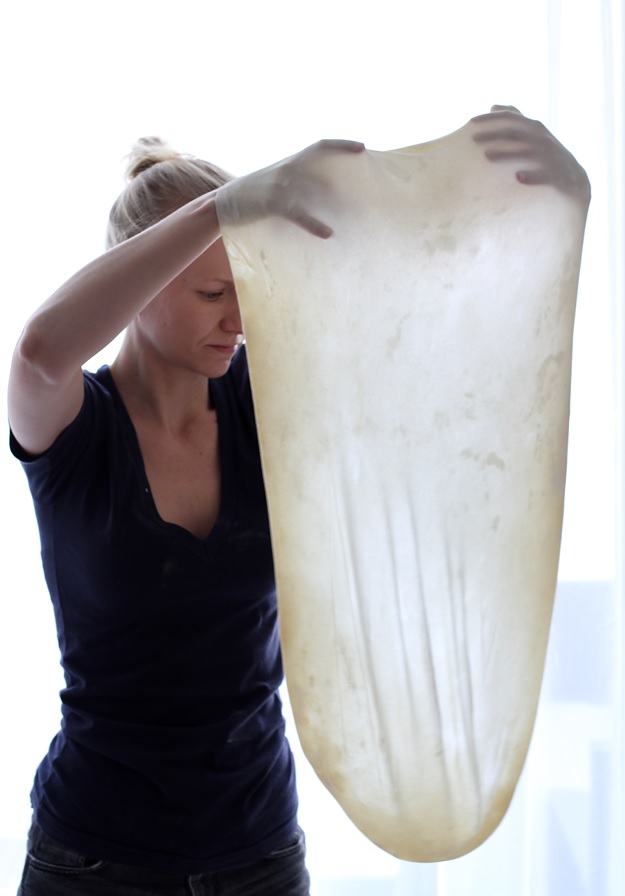
My history with strudel dough
I’ve been stretching strudel dough since early childhood. In kindergarten, my sisters and I ‘helped’ our granny to stretch strudel dough until super thin and way beyond (holes!). But who can blame a 4-year old to find out the limits of a dough that stretches as long and wide as our family table.
The stretching became more controlled during my years of elementary school and suddenly stopped in my teenage years. I guess barely any teenagers are really into cooking, right?
I kind of picked it up again when I went to college and returned home every few weekends to visit my family. Since we all love apple strudel in our family, my mom often made this treat on weekends. When I was home, I often lend my mom a helping hand.
During my years in Boston, I intensified this precious hobby. First, I made apple strudel for friends, then for the MIT cooking group (yes, they have a cooking group!), and later on, I was teaching at the Cambridge Center for Adult Education how to make apple strudel from scratch. My students always seemed to enjoy the strudel dough stretching part most. Once you get the knack of it, you’ll never go back to store-bought phyllo dough.
FYI: I already posted two recipes for apple strudels: my recipe for original Viennese apple strudel, which is my go-to recipe. And this apple strudel recipe that additionally contains walnuts and uses less butter and breadcrumbs.
Recipe for Apple strudel dough from scratch
Note: You can use this strudel dough not only for apple strudel but also for every kind of strudel with sweet or savory fillings since the strudel pastry doesn’t contain any sugar.
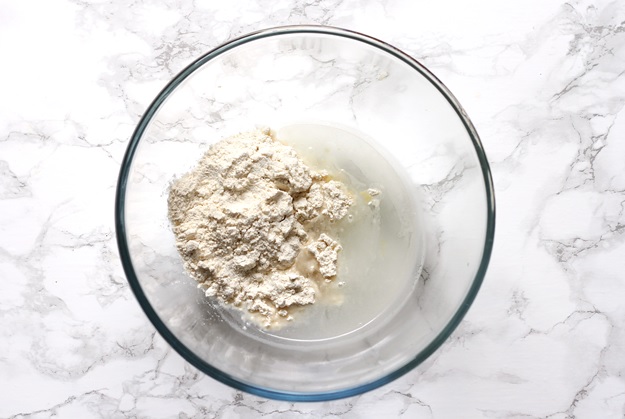
Add liquid ingredients and 1/2 of the flour to a bowl.
Mix water, oil, lemon juice, and salt in a big bowl. Acids like lemon juice or vinegar help relax the gluten and make the dough more elastic. Add about half of the flour ….
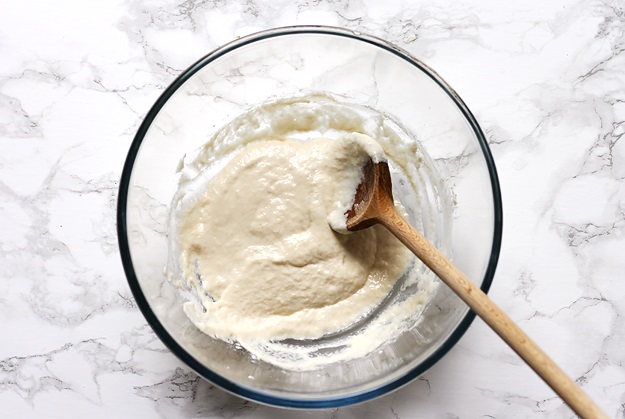
Stir, stir, stir. It should roughly look like pancake batter, which is easy to stir.
… and stir with a spoon until well combined. Stir this pancake-like batter for about 1 minute (helps developing gluten), then add the remaining flour.
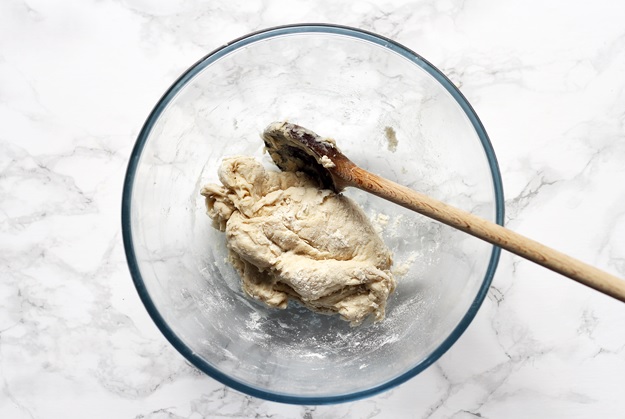
Add the rest of the flour and stir until the ingredients form a dough.
Work the flour in with the spoon, until a dough forms and you can work it with your hands.
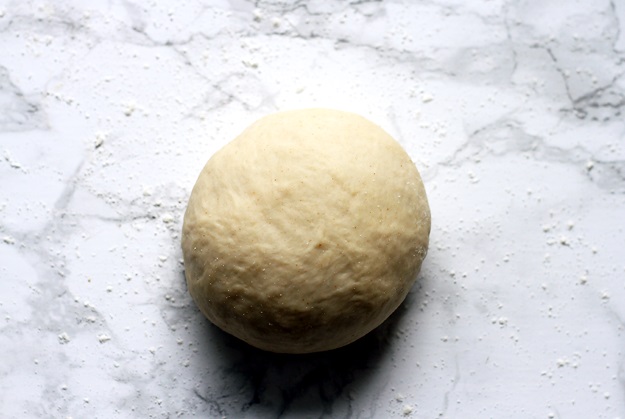
Knead the dough for 10 minutes.
Knead the dough until smooth for about 10 minutes, either in the bowl or on a working surface. The dough should be moist but not sticky. If it is too sticky to knead, add a little more flour. You shouldn’t need more than 1 or 2 additional tablespoons.
Slam the dough onto the counter a few times to enhance gluten developmen. This is also a good way for aggression/stress relief ;-) Shape the dough into a smooth ball.
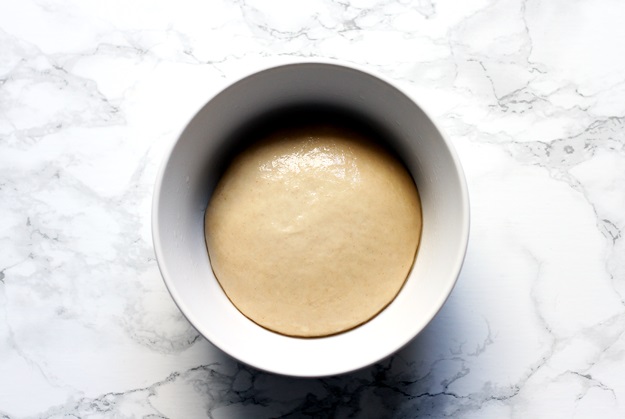
Grease a bowl, put the dough in, and let sit for 1 hour, covered.
Add 1/2 teaspoon of oil to a small bowl, distribute it with your fingers and turn the dough around to cover it with oil.
Cover the bowl with a lid or plastic wrap and let it sit for 1 hour at room temperature. You can also make the dough ahead and keep it in the fridge for up to 2 days. Temperate before using.
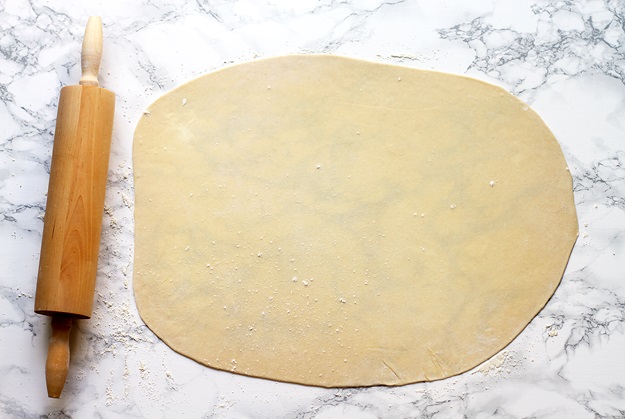
Roll the dough with a rolling pin.
Roll out the dough with a rolling pin on a lightly floured counter. Flour the counter and the dough every now and then while rolling. When the dough reaches about 13-15 inch in diameter (or even larger) …
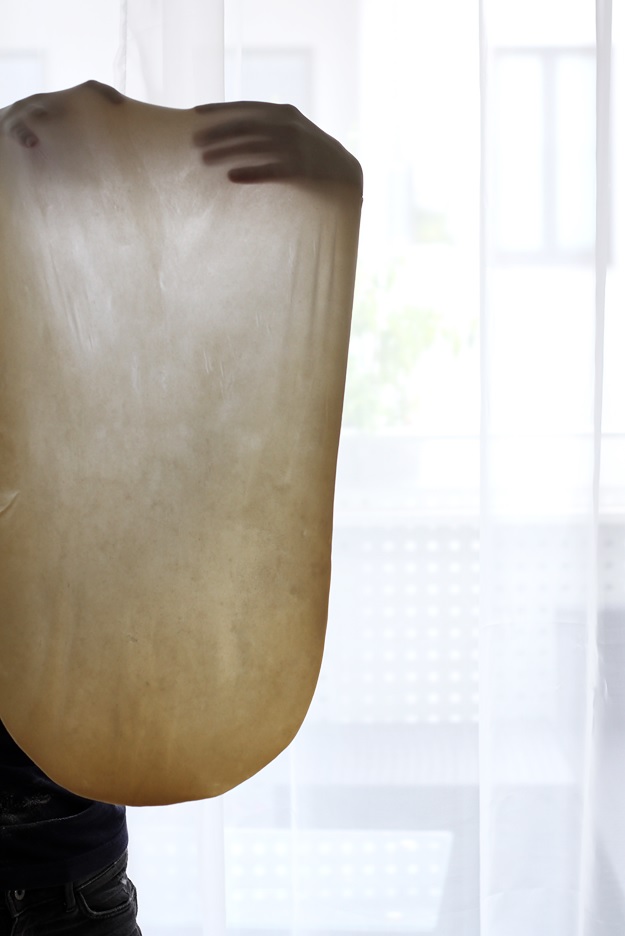
Pick up the dough and stretch it. Sorry I’m off center here, I used a remote controller to take the pic. It’s kind of artsy though ;-)
… pick it up then use the back of your hands, particularly your knuckles, to stretch it while turning it around (remove all sharp jewelry first) – kind of like pizza dough.
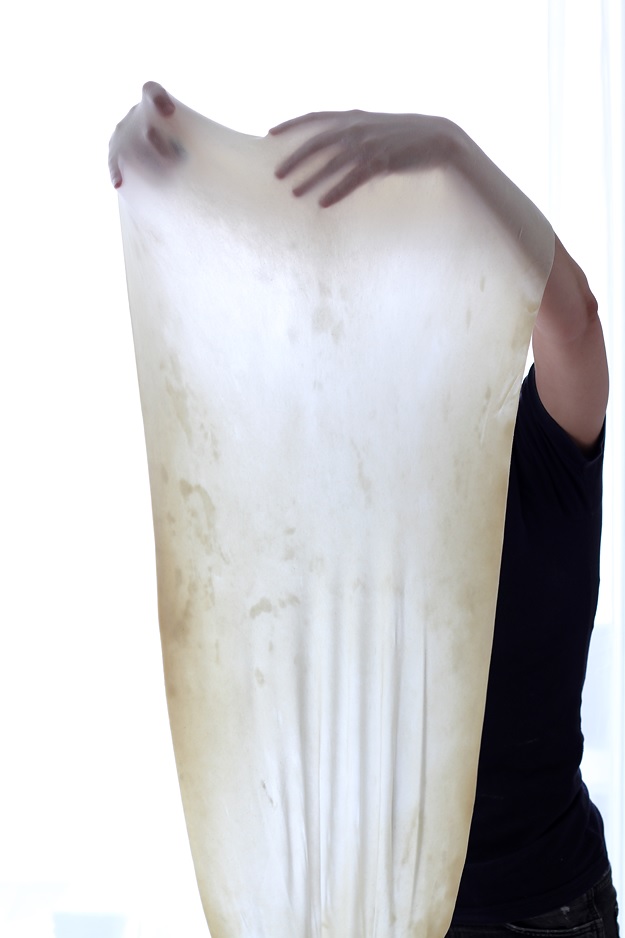
Stretch a little further.
When the dough gets bigger and thinner, and thus difficult to handle, put it down on a lightly floured tablecloth.
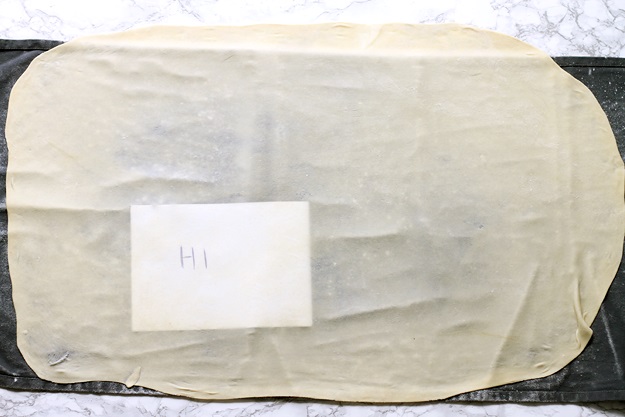
Put it down and stretch into a rectangle. The strudel dough should be paper-thin now and is ready for the filling.
Continue stretching the dough on the tablecloth using your hands. Note: This works best if two people are working on opposite sides since the tablecloth can be slippery – but I’ve made it alone very often too, so no worries.
Gently stretch the dough paper-thin from the inside to the outside, working your way around the sheet of dough. Stretch it until it starts to look translucent. You should be able to read the titles of a newspaper placed under the dough (don’t do this though, the ink would probably come off).
When finished, the sheet of dough should have a rectangular shape, with the shorter edge fitting the baking sheet lengthwise plus an inch on each side overhang.
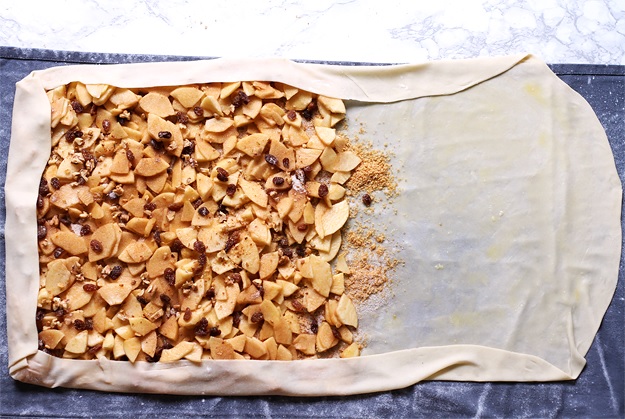
Add your filling. Here: apples, raisins, breadcrumbs, walnuts. Here is the recipe for the apple strudel in the picture.
Add your filling of choice, most of the time the filling is placed only on one half of the strudel dough, like with apple strudel. Brush the side without filling with melted butter.
Fold in the sides of the dough over the filling to prevent the filling from oozing while rolling. Using the tablecloth underneath, roll the dough, starting at the end with the filling. Then gently roll the strudel onto a sheet of parchment paper with the seam-side down.
Transfer the dough to a baking sheet and brush with melted butter. Put the baking sheet in the center of the preheated oven and bake it – for most strudels baking time is roughly 1/2 hour at 375 °F (190 °C).
When the crust turns golden, the strudel is ready. Take it out of the oven, let it cool slightly, cut it into pieces and serve dusted with confectioner’s sugar.
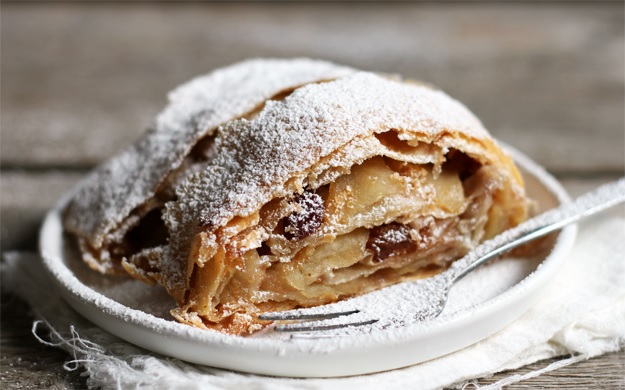
You can find the recipe for my Homemade Apple Strudel from scratch here. This is the one you see in the pictures above.

If you prefer an apple strudel without any walnuts, try my recipe for original Viennese apple strudel, which I posted a few years ago.
FAQ on how to make the perfect strudel dough
If you have further questions about making homemade strudel dough, like what to do when there is a hole or why the strudel dough doesn’t strech well, you can find the answers in my free ebook (click purple picture below).
I’ve put together this booklet to answer the most common questions about strudel dough in an FAQ to help you to get a perfect result straight away. The FAQ include many tips and tricks and is not available on the blog. These tips are all based on my personal experiences that I have collected over the years.
How to make Paper-Thin Strudel Dough
Ingredients
Dough:
- 1/3 cup lukewarm water (80 g/80 ml)
- 1 tablespoon + ½ teaspoon neutral tasting vegetable oil (15 g/17.5 ml)
- 1/2 teaspoon lemon juice or vinegar (2.5 g/2.5 ml)
- 1/8 teaspoon fine salt
- 145 g / 5.1 oz bread flour (about 1 cup + 1 Tbsp) (see note)
In addition:
- ½ teaspoon vegetable oil for brushing the bowl/dough
- flour for dusting
- large tablecloth
- parchment paper (recommended)
Instructions
To make the dough:
- Mix water, oil, lemon juice, and salt in a big bowl. Acids like lemon juice or vinegar help relax the gluten and make the dough more elastic.
- Stir in about half of the flour with a spoon until well combined. Stir this pancake-like batter for about 1 minute (helps developing gluten), then add the remaining flour, but set 1 tablespoon flour aside first, which you might need later*. Work the flour in with the spoon, until a dough forms and you can work it with your hands.
- Knead the dough until smooth for about 10 minutes, either in the bowl or on a working surface. The dough should be moist but not sticky. If it is too sticky to knead, add a little more flour. You shouldn't need more than 1 or 2 additional tablespoons. Slam the dough onto the counter a few times to enhance gluten development, also good for aggression/stress relief.
- Shape the dough into a smooth ball. Add 1/2 teaspoon of oil to a small bowl, distribute it with your fingers and turn the dough around to cover it with oil.
- Cover the bowl with a lid or plastic wrap and let it sit for 1 hour at room temperature. You can also make the dough ahead and keep it in the fridge for up to 2 days. Temperate before using.
Stretching the dough:
- Roll out the dough with a rolling pin on a lightly floured counter. Flour the counter and the dough every now and then while rolling.
- When the dough reaches about 13-15 inch in diameter, pick it up then use the back of your hands, particularly your knuckles, to stretch it while turning it around (remove all sharp jewelry first) – kind of like pizza dough.
- When the dough gets bigger and thinner, and thus difficult to handle, put it down on a lightly floured tablecloth, straighten out the wrinkles in both the tablecloth and the dough. Continue stretching the dough on the tablecloth using your hands. Note: This works best if two people are working on opposite sides since the tablecloth can be slippery - but I’ve made it alone very often too, so no worries.
- Gently stretch the dough paper-thin from the inside to the outside, working your way around the sheet of dough. Stretch it until it starts to look translucent. You should be able to read the titles of a newspaper placed under the dough (don’t do this though, the ink would probably come off).
- When finished, the sheet of dough should have a rectangular shape, with the shorter edge fitting the baking sheet lengthwise plus an inch on each side overhang. FYI, often people cut off thicker edges but I never do since I enjoy the doughy parts in the strudel.
Filling and baking the strudel:
- Add your filling of choice, most of the time the filling is placed only on one half of the strudel dough, like with apple strudel. Brush the other half with melted butter.
- Fold in the sides of the dough over the filling to prevent the filling from oozing while rolling. Using the tablecloth underneath, roll the dough, starting at the end with the filling. Then gently roll the strudel onto a sheet of parchment paper with the seam-side down.
- Transfer the dough to a baking sheet and brush with melted butter.
- Put the baking sheet in the center of the preheated oven and bake it – for most strudels baking time is roughly 1/2 hour at 375 °F (190 °C).
- When the crust turns golden, the strudel is ready. Take it out of the oven, let it cool slightly, cut it into pieces and serve dusted with confectioner’s sugar.
Notes
Did you follow this recipe? You could share your result here. All you need to do is take a picture with your smartphone and send it to [email protected]

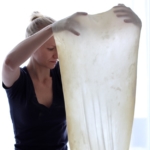
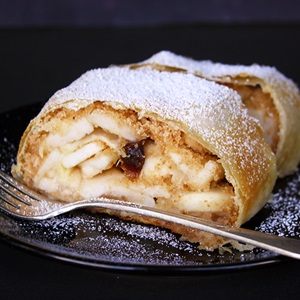


And I guess that if you don’t stretch it enough it will turn out rock hard, right? I made strudel from scratch (sweet nd savory) a couple of times and it always turned out good but hard to chew.
Exactly! Rock hard. If you stretc it really thin and brush the dough with butter, it will get layers of fine delicate dough. That’s what strudel dough should be like :-)
Looking at the comment above, when do you coat the dough with butter? I am wanting to make this today and read all the way through the recipe. I definitely don’t want it hard but I don’t see where you butter the dough. Thanks
Did you ever hear back about when to butter the dough?
I was wondering the same
Thank you
Hi Eileen,
I just realized, I never replied to the comment above. I did so now – hope this helps. Best, Ursula
Hi Bea,
So sorry, I just realized that I never replied :(
This depends on the filling. If you spread the filling over the entire strudel, there is no need to butter the rolled out dough. Simply brush the rolled up strudel with melted butter before you put it into the oven. When making strudel, I always put the filling on half side of the rolled out strudel and brush the plain side with melted butter to get some layers of dough. Hope you will try the recipe some time.
Ursula
Ursula, one of my favorite ways of eating Apfelstrudl is with Vanilla Sauce. By any chance do you have a recipe for that. It’s sort of like a thin custard with the consistency of medium-thin gravy.
Hi Julie,
I also love strudel with vanilla sauce. I usually go the lazy route and make vanilla pudding from a package like jello (where you just add milk and sugar). I add more milk though, so that the sauce is not as firm as pudding but like a light vanilla sauce.
If you want to try a vanilla sauce from scratch, you can try this recipe:
Heat ½ cup milk and ½ cup half and half (or heavy cream) with 3 Tablespoons sugar and 2 teaspoons vanilla extract or vanilla sugar. Place 4 egg yolks in a bowl and briefly whisk (5-10 sec). Slowly ladle the hot/warm milk mixture into the egg yolks while whisking. Return the mixture to the pot and heat over medium low until the sauce thickens (don’t let it boil vigorously as it might curdle), about 5 min. Strain the sauce if eggs have curdled a bit. Thin with more milk if sauce is too thick and serve warm with the strudel.
Hope that you’ll try it some day! Ursula
Oh wow!
My Grandmother used to make strudels like this, but they were savory… but in a completely different manner. She’d roll them super flat out, stretch them, then gently bunch and gather the dough to form noodles, gathered with air pockets. Sometimes she’d chop up dates as a filling. Then she’d boil the noodles in pork broth made from pork hocks boiled for hours in the oven.
Every time I look up “strudel dough” all I get are the dessert pastries. It’s impossible to find recipes for the variety I’m familiar with. This was super close, though! :D Very nice to see.
Hi Crystal,
Thanks so much for your comment. Honestly, I have a hard time picturing the process you’ve described above. In particular the ‘gently bunch and gather the dough to form noodles gathered with air pockets” part. Not sure if I know these kind of noodles.
You can use this dough for savory fillings too (e.g. spinach) since the dough tastes neutral and doesn’t contain any sugar. But I think this is not what you have in mind ;-) Do you have a name or picture for these kind of noodles? Maybe I’m able to find some information for you.
Yeah. I realize now they’re a bit different! Yours are more like a mille-feuille pastry dough. The noodle-y strudel dough is done very similar, though! My great-grandmother, grandmother, and mother didn’t have an exact recipe, so they eyeballed everything and never really passed on any tips for the dough; your recipe actually came in REAL handy for that with the tips for that pancake dough consistency resting.
Unfortunately, I do not have any videos or images of the process, because it’s super not common. :( It appears to be a German/Austrian/Romanian thing. I did manage to find a handful of references when I used the term “boiled strudel” in Google. Otherwise, here’s my method:
1 cup warm water, salt, enough AP flour to make that pancake-like consistency goop that you let sit for 30 minutes. After, you add enough flour to make into a smooth and slightly tacky dough ball and knead (and slam!) for 10 minutes. Oil a bowl, rub oil over top of dough, let sit 60 minutes covered in plastic wrap/kitchen towel. Divide into 4 mini balls and gently roll out about half an inch thick. Re-oil lightly to prevent sticking, fold in half, place on lightly oiled baking tray and cover with plastic wrap/kitchen towel.
And then it diverges a bit from your recipe. After 15 minutes, don’t use any flour or roll out the dough; just start stretching it by hand using the knuckles method or holding by the edges. Get to twice as thick as “newspaper” thin, then lay down the dough on a NOT COLD surface. Lift the edge lightly taking care not to rip, reach a hand into the middle, palm up, and slowly lift the dough up and down gently (like gentle waves) to stretch the dough out to “newspaper” thin. Once the dough is all stretched out super thin (slightly thinner than yours), at the top of the dough, gently lift about half an inch of dough off the counter/table, and then drop it directly down onto itself (closer to you), so it sort of folds over itself. Repeat lifting half an inch of the dough and bringing the edge furthest away going towards you; don’t roll it!
With the “noodle” now complete, place it back onto the lightly oiled sheet pan, cover with plastic wrap to prevent drying, and do the rest like that. You should have 4 long puffy noodles. Boil them in pork broth for about 15-30 minutes, until tender. Serve with roasted + boiled pork hocks/ankles, boiled potatoes, carrots and onions (in the same broth as the pork hocks), and thicken up the leftover pork broth slightly to create a sauce for everything.
My great grandmother sometimes chopped up dried and pitted dates into tiny bite-sized pieces (raisin sized), and sprinkled a small bit onto each noodle before bunching and gathering. My mother tweaked this recipe slightly by adding a tiny bit of baking powder to the noodle dough to make the noodles fluffy instead of being so dense. Go easy on the baking powder, maybe 1/2tsp for a small batch like this, otherwise you’ll end up with the noodles poofing up so much they boil out of the pan!
Ack! I forgot, add one large egg to the warm water + salt water, and blend nicely.
Here’s a recipe I found yesterday with an image: https://carolynschott.com/uncategorized/strudels-for-dummies/ They cut their noodles into 2 inch long pieces, though, before boiling. Either’s fine, really.
Hi Crystal,
I think I’ve never heard (or seen) of these kind of noodles. At least the picture isn’t familiar to me. Very interesting! And thanks so much for writing down the recipe. At some point, I have to try it. I know what you mean when saying they eyeballed everything. “Mix until the dough is right” is common in my family too :-) I hope you will be successful in recreating the recipe. Sounds like you do a lot of research.
Have a nice weekend and let me know when you found the perfect noodle recipe :-)
Hi Crystal (& Ursula),
you’re talking about “Bessarabian Strudla” here. My grandma also made these strudla (also called studeln), it’s a home-made pasta dish and tastes fantastic. But they have nothing in common with a strudel (apart from being made of a wheat dough…).
Here you can find another recipe https://www.bessarabien.blog/strudla/
Lea
Hi Lea,
Thanks so much for the info! Interesting!!
My Romanian grandmother made strudel noodles very similar to what Crystal and Lea have described above. Her recipe was simply flour, water, and salt. Once the dough was stretched thin, about the size of the kitchen table, she would gently ruffle/gather the long side together, forming a long loose ‘noodle rope’. This would then be cut into lengths of about 12 inches (30 cm) forming large noodles. These noodles were then steamed in a large roasting pan over a bed of beef or pork, potatoes and water, with the lid on, for about half an hour. The steam gently cooked the noodles and kept them a little lighter and fluffier than if cooked directly in liquid.
They were a family favorite and a true art form!
Hi Maxine,
this dish sounds so interesting! I still don’t know what it is called, but it sure sounds delicious :)
Ursula
This is exactly how I learned it from my mom (and from her Viennese mom), but how do I make sure it doesn’t get gummy and sticky – and keep it more flaky? (total beginner)
Hi Kate,
Do you mean gummy and sticky when rolling it out and streching it? If you, simply use enough flour that this doesn’t happen. It never happened to me :-) It’s worth a try. The key is to stretch it out really thin, otherwise the pastry will be rather firm and hard. Ursula
i have a question: is there any kind of raising agent in the batter? do you use self-raising flour? or does the filling and brushed-on melted butter separate the layers enough?
Hi Anne-Marie,
There is no rising agent in the dough at all. In fact, it shouldn’t rise. If you brush the strudel dough with melted butter before rolling it into a log, it will separate the layers. That’s all :-)
Thank you so much for this recipe! My grandmother was Austrian (and her mom’s first name was Ursula as a cool coincidence given I’m sure that’s where my grandma learned to bake from!), and as a toddler I remember her and my mother getting up at 4 am every Sunday morning when we were visiting to make strudel (they would fold it many dozens of times and re-stretch (not sure why, I’m guessing it makes some difference but I’m not a cook so I’m not sure what?), but it made it much more time consuming, but your recipe to me taste just like theirs was, I haven’t had it for probably 35 years or so but it brought back also a flood of really nice memories (not just about strudel making).
The only thing I did different was to use a tbsp of boiling water to mix with with the flour first before mixing in the rest of the water just because I remember them doing it that way (I’m guessing it does the same essential thing as the acid would, breaking down those protein chains) which makes the dough more stretchy and less liable to get holes.
Anyways, thank you, though it’s a bit early, this made my Christmas season! I’ve tried many strudel recipes and yours is by far the most authentic (i.e. tastes most like Grandma’s, haha) I’ve found. Sooo happy (as will be my daughter when she comes home for a visit and I’ll send her home loaded up with strudel).
Hi Greg,
Thank you so much for your lovely comment. I am so happy that you like the strudel and that it resembles the one your grandmother and your great grandmother Ursula ;-) used to make. I’d guess too, that the added hot water is for gluten development. I hope your daughter will love it too. Ursula
What are your thoughts on substituting lard for the neutral oil in the dough? It seems to make the crust a bit more flaky, and I tend to prefer the flavor. My mom says that back in Germany, she used to make it with bacon fat.
Hi Thomas,
Sure, go for it! I personally have never tried it but if you like the taste, why not? It should work fine as an oil substitute. Hope you will try the dough. Ursula
This may be silly, but what kind of tablecloth do you use? I have hopelessly been searching but have not quite found an answer
Hi Tina,
Not silly at all! I’ve tried it with a lot of different table cloths, and so far all of them worked fine. I found the heavier ones (as in thicker like linen or tight cotton) somehow better. But as you can see here: https://www.lilvienna.com/original-viennese-apple-strudel/
it also works with very light ones. Hope this helps! Ursula
If I failed stretching the first time. Can I roll it into a ball and rest it again for 20mins before trying again? Will it work??
Hi,
Yes, you can roll it into a ball and try it later again. If you used some flour for rolling the dough out before stretching it, you may add some drops of water or the dough might get too dry. Simply wet your hands and/or the counter and knead the dough. Wet your hands a couple of times to work in the moisture. Let it rest after this, 20 minutes should work. Ursula
I LOVE Apfel Strudel!! I studies in France, and when I traveled in Austria, I ate Apfel Strudel every day that I could!
Today I am gluten sensitive. Is is possible to make the Apfel Strudel crust with gluten free bread?
I fear it is not – however, I thought I’d ask you, the voice of experience, and find out whether you/ve ever tried it… Thank ou!
Hi Mary,
Honestly, I don’t think it is possible to make it gluten-free. Since gluten is the reason why the dough is elastic and stretchy. But I am not an expert in this field….. You could try making phyllo dough with gluten-free flour (or even buy it). Phyllo dough usually works quite well for apple strudel. Or even gluten-free puff pastry.
Great that you enjoyed apple strudel in Austria many times. It’s quite different from place to place so there is a lot to explore. Ursula
Dear Ursula,
Thank you so much for this spectacular recipe! It was my very first time ever making strudel dough, so I tried to follow your directions perfectly – at first, when I started stretching the dough, it was working very well! However, after a little bit, it started cracking in a bunch of spots, and I got a lot of tears in the dough…do you think this is because I sprinkled it with too much flour while rolling it out and kneading it? So it got too dry? Or it could be because of something else? When I formed the ball of dough (before letting it sit), it wasn’t perfectly smooth, so maybe that’s why?
I would so appreciate it if you have any suggestions as to how I can improve next time!
Thank you so much.
Kindest wishes,
Savannah
Hi Savannah,
So happy that you tried the recipe! It seems like the dough was a bit too dry. I guess you have measured the flour by weight? If not, do so the next time. If you already did, it could be that the flour you are using needs a little more liquid. So I would suggest that you use 20g less flour and see if it comes together to a smooth yet slightly sticking ball of dough. It should not stick too much though. Only work in the 20g if needed. While resting, only use very little oil to brush the dough and bowl. Otherwise, it’s hard to roll the dough without having lumps of flour sticking to it.
When rolling, I sprinkle just a little flour on top of the dough, distribute it evenly with my fingers, so the dough is only covered with a light dusting, roll it. When still small enough to handle, I turn it around, dust the counter and the dough surface and repeat until rolled out to the the size of a baking sheet. Then, I stretch it further by hand.
So it seems to me that the dough was either a bit dry from the beginning or you used too much flour while rolling it out. I hope this helps in some way. Good luck for the next time, Ursula
Hello Ursula! Thank you for sharing your recipe. My Hungarian mom was well known for making delicious apple strudel and now I’m trying to replicate. My grandmother also baked a lot and I remember many traditional recipes. Now it’s my turn to try. Your dough recipe is very nice and easy to work with. As a coincidence, my name is also Ursula, so I knew this was the recipe for me!
Haha, hello Ursula :)
I hope replicating your mom’s strudel did work out. Thank you so much for sharing your story here. I always find it fascinating to hear about the different backgrounds and motivation why people want to bake strudel. All the best for your future baking endeavors! Ursula
thanks!!!!
i want to make chocolate poppy seed strudel
do you have a recipe?
thanks
kim
Hi Kim,
No, unfortunately not. But I’m posting a recipe for poppy seed brownies soon :) It sounds delicious!
Hi! A question, no egg in the dough mixture/recipe?
Hi Ann Marie,
Nope, there is no egg in the dough. It’s naturally vegan. Best, Ursula
Thank you for such a great explanation! I will give it a try.
Can I use this dough to prepare individual size strudels? When should I divide the dough in smaller portions? Before stretching or after?
Claudia
Hi Claudia,
Sure you can make individula size strudels. I would probably strecht the dough, then cut it and then fill the individual pices. I think it is rather hard to stretch a lot of small dough pieces. Hope you’ll try it :) Ursula
Thank you, this is a great recipe and I had lots of fun stretching the dough. I live in a very dry winter climate and know from experience that doughs are often too dry due to lack of humidity in the air. So I held back 15 grams of flour and it was perfect. My question is: What final dimension is ideal with the stretched dough? I was just worried that I was stopping too soon even though it was mostly translucent. It didn’t appear as big as yours in the photos.Your recipe was greatly appreciated by my family tonight!
Hi Bobbi,
So happy to hear that you and your family like the recipe.
The dough should be stretched into a rectangular shape, with the shorter edge fitting the baking sheet lengthwise. In my case, this was around 45 cm (18 inch). My baking sheet is 40 cm long, so if you stretch the strudel to 45 cm (short side) and fold in the sides before rolling, it fits onto the sheet without bending. The long side doesn’t really matter but it usually is around 75 cm (30 inch). But of course, you can always stretch it longer and wider – the strudel will become thinner and you might have to bend it like a horseshoe to fit onto the baking sheet. Everything works :)
Hope you’ll make it again some time!
Ursula
Ps: I love this version with walnuts: https://www.lilvienna.com/homemade-apple-strudel/
Hallo Ursula,
mit Strudel verbinde ich sehr viele Erinnerungen an meine Oma. Ich war immer fasziniert, wenn sie ihn auf dem Küchentisch hauchdünn ausgezogen hat. Ich habe einige Rezepte schon ausprobiert und es hat nie funktioniert wie bei meiner Oma. Jetzt bin ich auf dein Rezept gestoßen und was soll ich sagen, ich hatte beim ausziehen Glücksgefühe. Da lag auf einmal der perfekt ausgezogene Teig ohne Löcher auf dem Tisch. Meine Oma wäre stolz auf mich. Danke für das tolle Rezept und die ausführliche Erklärung. Jetzt wird es sicher wieder öfter Strudel geben.
Liebe Grüße Alex
Liebe Alex,
You made my day :) Das freut mich wirklich sehr! Super, wenn das Rezept für dich passt. Dann wünsche ich dir noch viele köstliche Strudel.
Alles Liebe, Ursula
Hey Ursula,
1) thanks for posting detailed recipe.
Very cool. Super excited. I actually am going to make something that’s not Apple strudel but I place to use your dough. Looks super. Going to try and do something with meat inside. Usually I pan sear this meat for about 10 min to get the flavors and juices, but in this case I’m going to cook it for two minutes to get the flavors then I’ll put the semi cooker meat in the dough. I wanted to make something for a big dinner of 25 people and I don’t want them to know what it is. This will be perfect.
2) Generally speaking, how many people do you think your dough can serve? I may have to make 2.
Hi Oscar,
This recipe is for one large strudel. Depending on if you serve it as a main or dessert, it makes up to 10 servings (filled with apples). But usually, I would make one strudel for up to 6 people, just to make sure everybody get seconds :)
If you fill it with meat, actually I have no idea. But it’s never wrong to double the recipe. Have fun strudel stretching! Ursula
Can you use a standing mixer to mix the dough?
Yes, you can. It’s just like pasta dough. So if you have a sturdy stand mixer with dough hook, you are good to go. Ursula
I’m making your strudel recipe to make 9 strudels for our German American Club Oktoberfest held this Saturday.
Instead of kneading by hand, I want to use a kitchen aid.
How long would your recommend kneading the dough in the machine?
I’m also doubling the recipe to make two batches of dough at a time.
Any thoughts?
Vielen Dank!
Jasmin
Santa Cruz California
Hi Jasmin,
I would knead the dough in the machine for 8 minutes and then see if it’s smooth. If not keep kneading for another 2 minutes. That will definitely do. The amount of flour that you’ll need for 1 strudel is pretty little, so I think you could even triple the dough and do 3 batches. While you stretch one strudel, make sure to keep the other doughs tightly covered (I always put them in a container with lid). Hope this helps! Have fun at the Oktoberfest :) Ursula
I wanted to make apple strudel for ages and thought to give it a try today. Kneading the dough was harder for me than stretching and rolling it after; it wasn’t wet as much as sticky and difficult to knead well. I had to do it over 20 minutes with different techniques in order to pass the windowpane test. Was quite fun, though. After resting in the oven with the light on, it was quite easy to stretch and roll. I even surprised myself how thin I managed to stretch it. It baked well, and the filling didn’t leak out. I’m amazed how wonderful it turned out! Thank you for a wonderfully detailed recipe.
Hi Mark,
I’m surprised to hear that not the stretching-part was the most difficult for you but the dough kneading. The dough consistency after a few minutes of kneading should be moist, but not really sticky. This often times depends very much on the flour. Simply add a sprinkle of flour, if too wet or wet your hands and/or work surface a few times to knead some moisture into the dough if you feel that it is rather firm and dry and not easy to knead. I have to admit, it will probably take a few trys to know how the dough should behave. Happy to hear that you managed the stretching so well!! Congrats :)
such a great recipe, so easy and elastic! Mine turned out so nice. Thank you so much!
Hi,
So happy to hear that!! I love short ingredient lists so this dough is a favorite of mine. Thanks so much for making the dough and happy that you liked it. Ursula
Okay I’ve tried to make this dough several times and it was always too dry and hard to stretch. Are you forgetting eggs in the recipe? The Austrian videos I’ve watched have an egg in the dough and that’s made them more pliable. I’ve had to throw the dough out 3 times now:(
No idea what I’m doing wrong. I’m going to try the recipes with egg.
Hi Maggie,
So sorry to hear that! I know how frustrating it can be when a recipe doesn’t turn out well.
To answer your question: no, there is no egg in the dough. I‘d say half the doughs for apple strudel in Austria are made without eggs, the other half with egg(s). So this is definitely not the reason for the dry dough. Usually the reason is the flour. The dough should be kind of moist when kneading. At the beginning even a little sticky. After 10 minutes of kneading it should not be sticky any more but just soft and easy to work with. Your dough sounds too dry. If you are ever in the mood again for another try, make sure to measure the flour by weight (I often use King Arthur bread or ap-flour, or Whole Food‘s bread or ap-flour (365 brand). And add 2 tablespoons more water as written in the recipe. Look for the dough consistency I‘ve described above. Make sure to cover it tight while the 1 hour resting time. Usually, this dough is super elastic and easily to stretch.
Again, so sorry that all the attempts didn’t turn out well. Ursula
Hi Ursula,
I’ve been looking for a “proper” strudel recipe for ages.
I used to watch my Jewish Romanian grandmother make hers (the best) when I was a kid.
She would stretch it on her knuckles walking around the kitchen table, fixing tears as she went.
She used various nut and fruit fillings and coiled it in the oven. When I was older I asked my mother if she could get Bubbie’s recipe. She came back with “flour and water mixed to the right consistency”.
Much like her delicious honey cake. I was told it had honey and flour and walnuts, etc. When I asked how much of each the response was “depends on how big a cake you want to make”.
I’ll have to give this one a try.
Thanks,
Les
Hi Les,
Haha, yes I know. Grandmothers often cook without measurments “until the dough feels right” :) I hope you’ll give the dough recipe a try. I bet it’s perfect for the honey-walnut cake! Best, Ursula
Hi Les,
Yes, please give this strudel dough recipe a try. It’s super easy – just mix flour and water to the right consistency lol. I know, ‘granny-measurments’ are often times like this, which doesn’t make it easier if you don’t know what the right dough consistency is. This dough sounds like a good fit for the famous honey cake. But you can literally use it for anything – apple strudel, nuts, fruit, Topfen-strudel (curd cheese strudel), or even savory meat or vegetable strudels. I hope you’ll try the recipe. Thanks so much for your comment and good luck stretching strudel dough until paper-thin ;-) Ursula
My mother made similar. She was from Baden-Wurttemberg, Rottweil am Neckar, a similar culture to most of Austria.
Hi John,
Happy to hear that your mother made a similar strudel dough. I bet it was delicious!! I hope, you’ll try it some day. Making homemade strudel dough and stretching it is always fun :) Ursula
My grandmother always made apple or cottage cheese strudel. I have made them for years . I stretch very thin , cover with butter and roll by lifting the cloth. I often get a Crack on the top and the filling is exposed or even spilling out occasionally. Why and how do I fix that?
Hi Karen,
Happy to hear that you make cottage cheese and apple strudels! Cracks ocasionally happen. I sometimes have a tiny bit of apple filling oozing out at the botton (but never on top). Usually, the strudel dough stays intact though and does not crack. I would guess that the dough is rather too dry and therefore can not expand enough and cracks. Try adding a tiny bit more liquid to the strudel dough, maybe this helps. Ursula
My dad grew up in Hungary from a German speaking family.
Once in Canada, my Oma would invite the family once in the winter for strudel. She would serve homemade soup first followed by strudel with at least two different fillings: poppyseed, apple (rarely), sour cherry and cheese, and sometimes savoury like carrot and cheese or cabbage (her favourite but not ours!). My uncle would always say that the dark one, poppy seed, needed more “dirt”. My dad passed on a recipe for the dough with lard as the shortening but I much prefer yours with oil. When I got married I was given a “Strudel Tuch” (table cloth) made of linen. I am now passing this lovely, tasty ethnic recipe on to the next generation using your recipe. Thanks.
Kathie
Hi Katie,
Thank you so much for sharing your story. This is so interesting and the “more dirt” part made me laugh out loud. Sounds reasonable – the more poppyseed filling the better :)) and the expression could be from one of my uncles as well hehe.
So happy to hear that you’ll pass my strudel dough recipe on the the next generation. It’s such an easy strudel dough recipe with recipes that I have always on hand. Thank you for your lovely comment and I hope that you’ll make many more strudels.
Best, Ursula
Thank you so much! I have a memory of when I was maybe 7 or 8 of my grandmother making strudel, and stretching the dough using a clean I think floured cloth. That would be about 75 years ago but it has stayed with me. I loved that grandmother and spent quite a bit of time at her house — your post has brought those lovely memories back. My table cloths are blends [wrinkle-free] but I think a cotton sheet would work. Once as an adult I tried to make it without much success but I’m ready to try again thanks to your website. Toby on Salt Spring Island BC Canada.
Hi Toby,
Thanks for sharing your lovely memories of your grandmother. I love to hear those stories!!
Yes, a sturdy cotton or linen cloth works fine. Lightly flouring it helps to keep the dough from sticking. I know that making strudel from scratch is pretty intimidating. I also prefer to make it with a helping hand: someone that can speed up the process a bit, which prevents the dough from sticking to the cloth. Also: With 4 hands, you can easily transfer the strudel to the baking sheet :)
I hope that you’ll try the recipe some time.
Best,
Ursula
I was wondering if this dough works for an angel food streudel. Trying to make it that it cuts and stays together for a wedding cookie display.
Thanks,
Cyn
Hi Cyn,
I know Angel Food Cake but I’ve never heard of Angel food strudel before, so I had to look it up. I guess it would work. In Austria, this type of strudel dough is used for all kinds of fillings, like strudel with apples, with curd cheese/ricotta, also savory fillings like cabbage. So I see no reason why it shouldn’t work. Let me know if you try it. Always curious how it turns out! Ursula
My Mom passed away last year at 93. We had streudal for breakfast,lunch and dinner growing up, all kinds. Today I am making turnip streudal, my favorite. It’s my second try, I first made it several years ago after working with my Mom the week before. I had a tough time stretching the dough enough and it came out chewy. I gave some to my Mom and she said it was “edible”…lol. Well, her recipe doesn’t call for any acid, if I can’t stretch it well enough I’ll try some lemon juice next time.
Hi Bob,
Sorry to hear about your Mom’s passing. She sounds hilarious (‘was edible’) :)
The acid makes a litte difference but I’ve sucessfully made strudel dough without any vinegar or lemon juice too. If the dough doesn’t stretch well, it’s often time the type of flour (too little protein ergo gluten) or often the dough is simply too dry. I hope you’ll try this strudel dough recipe for your turnip strudel (which sounds lovely by the way) some time.
Ursula
Thank you for this recipe! My dad used to make this with his mom and wanted to pick it back up as a holiday tradition. I tried using her recipe and it would not stretch (called for a mixer) and I am much better at kneading by hand so I can feel the texture. Thanks to your recipe we were able to make 6 today (apple-raise and cinnamon-orange-walnut mix with apple)! That’s the double what we usually do. Thank you.
Hi Allison,
Oh wow! I also love to knead by hand for this reason. Your strudel variations sound super delicious!! So happy to hear that the recipe turned out so well!
Ursula
Hi Ursula,
Can I assemble the strudel (stretch the dough, fill it, and roll it) and then refrigerate it for a couple of hours before baking? I am hoping to make it to take to a friend’s house and then I can bake the pre-assembled strudel at her house. If that’s not possible, I can bake the strudel at home but I am wondering how long the strudel would stay crispy or would the juices from the apples turn it soggy if not eaten immediately?
Any tips to make it ahead would be greatly appreciated. Your strudel recipe looks amazing and I would like to share the result with my friends.
Sincerely,
Evelyn.
Hi Evelyn,
If the strudel is prepared and assembled a few hours in advance, the apples are moist and might soak the dough (one hour might not be a problem). I think the easiest way to make it ahead is to prepare the whole strudel as written in the recipe, bake it, bring it to your friend’s house and put it in the oven at your friends house for about 10 minutes to crisp up the crust. That should work. Hope that my reply doesn’t come too late! Happy new year, Ursula
Hi Ursula,
This will be my first time trying your recipe. You call for 1 Tbsp + 1/2 teaspoon of oil for the dough. Are you using all of this for the dough, or is the 1/2 teaspoon being set aside for brushing bowl/dough? Also, I have seen other dough recipes that use an egg in the dough recipe. Thoughts? Thanks, Frank
Hi Frank,
All of the oil is used for making the dough. That’s why I have listed another 1/2 teaspoon in the “In addition”-list in the recipe. Some recipes use an egg for the dough, others don’t. My family never uses an egg so I don’t either :) Hope that you’ll try the recipe some day.
Ursula
Hi,
Thank you for posting it. I used ANOTHER recipe yesterday. Have not made Strudelteig in ages. I failed miserably.
Then I saw your recipe and came back today and tried YOUR recipe. It came out so well. Stretchy, no holes! That tip with vinegar is key. Also, I had first used the wrong flour (holes bigger than dough!!!). I bought bread flour as you recommended. And also thank you for reminding us that the dough needs to be brushed liberally with butter before rolling or otherwise the layers become hard.
Thank you for your wonderful post.
So happy that your strudel dough turned out so well, especially after trying that other recipe…. Thanks so much for letting me know, you made my day!! Ursula